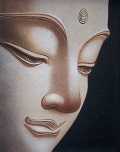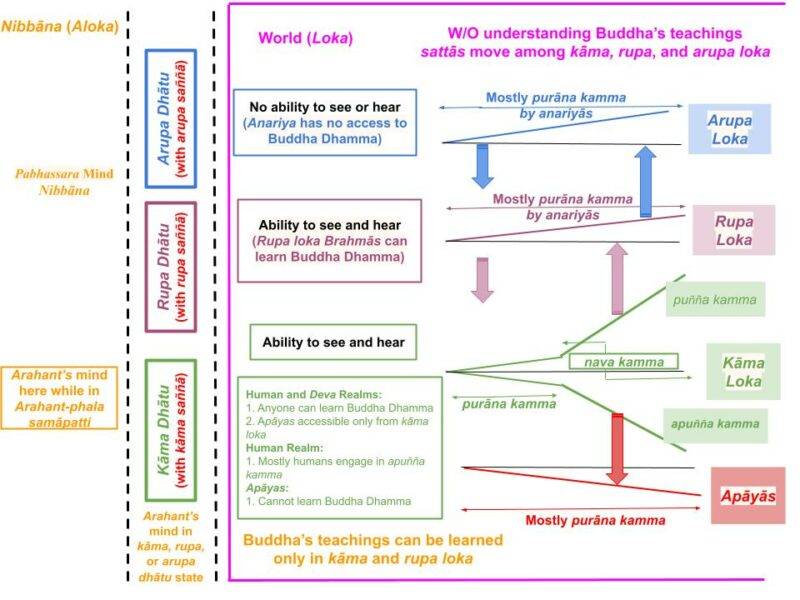- This topic has 7 replies, 2 voices, and was last updated 9 months ago by
Lal.
-
AuthorPosts
-
-
July 1, 2024 at 2:23 am #50595
Yash RS
ParticipantIn order to cultivate jhana, what Sensual faculties’ cravings must be suppressed (atleast), all the six senses or just the three- taste,touch and smell?
Is it possible for a person cultivating jhana to enjoy sounds and sights, as these belong to the Rupa category.
So for rupa jhana, only the above three should be suppressed, right?
-
July 1, 2024 at 6:18 am #50597
Lal
Keymaster1. To attain jhāna, one must transcend the kāma loka.
- We are trapped in kāma loka because we crave “close contact” (taste, smell, and body touch). However, we also use the other two sense faculties to fulfill such desires. For example, watching adult movies or talking about tasty food is done with kāma rāga.
- To attain a jhāna, one must overcome such desires.
2. That can be done in two ways:
(i) One must see (with wisdom) that the consequence of having such desires is to be trapped in kāma loka. Also, based on such temptations, we may do immoral deeds and be reborn in an apāya.
(ii) Kama rāga arises based on kāma saññā. To eliminate kāma rāga, one must overcome kāma saññā. If kāma saññā is inherent, we cannot overcome it. But kāma saññā is “mind-made” and can be overcome. See “Saṅgīti Sutta (DN 33.)“: “Paṭhamaṁ jhānaṁ samāpannassa kāmasaññā niruddhā hoti.” OR “For someone who has attained the first absorption, sensual perceptions have ceased.”
- That is why I call it a “distorted saññā.”
2 users thanked author for this post.
-
July 1, 2024 at 12:10 pm #50613
Yash RS
ParticipantSo only the three close contact( touch ,taste and smell) sensory cravings are to be eradicated or suppressed.
The other three ( sight, sound and thoughts) are used to access the above three.
If the close contact ones are eradicated or suppressed enough, we attain the Rupa jhana.
And if the other two- sight and sound, are eradicated or suppressed enough, we attain the Arupa jhana.
So a person, having attained the Rupa jhana, would he have cravings to see beautiful sights and to hear melodious sounds?
-
July 1, 2024 at 12:17 pm #50614
Lal
Keymaster“So a person, having attained the Rupa jhana, would he have cravings to see beautiful sights and to hear melodious sounds?”
- Can such a person have kama sankappa or “sensual thoughts” (while in the jhana or when trying to get into the jhana)?
-
July 1, 2024 at 12:19 pm #50615
Yash RS
ParticipantHe won’t have Kama raga but still have Rupa raga though.
I got it now,Kama raga is for cravings of pleasure
And Rupa raga only to see and hear?
1 user thanked author for this post.
-
July 1, 2024 at 12:34 pm #50617
Lal
KeymasterYes. For example, an Anagami likes to see bhikkhus and other disciples and discuss things with them, but does not want to watch adult movies or discuss tasty foods.
- Anariya yogis who still have kama raga anusaya/samyojana will still not generate sensual thoughts while trying to get into the jhana or while in the jhana.
2 users thanked author for this post.
-
March 5, 2025 at 2:25 am #53772
Yash RS
ParticipantCan I use Light as a meditation object for cultivating jhanas? I feel a strong sense of relief whenever I see white light. In this sermon,Ven.Waharaka Thero says that how the qualities of Aloka(light) can be used as a karmasthana. Aloka would mean transcending the loka, or Nibbana. Because of this nature of mind, light exists that has the quality to help us see the hidden or eradicate darkness. I am thinking of doing this with also using the dhamma meaning of aloka while focusing on light.
-
March 5, 2025 at 11:03 am #53778
Lal
KeymasterNo. The Thero does not advise to focus on a light.
- The English translation at the beginning can be misleading: “Be illuminated with the disintegration of desire.”
- The correct translation is: “Be released from the loka (aloka; commonly pronounced as āloka) with the disintegration of desire.”
- As you pointed out, “Aloka would mean transcending the loka, or Nibbana.” That is depicted in the following figure.

It is from “Pāth to Nibbāna – Learning Dhamma to Become a Sotapanna.”
_____
1. Of course, an anriya jhana can be cultivated by focusing on an object belonging to the world.
- Those are anariya kasina meditations. They focus on light (tejo), a clay ball (pathavi), breath (vayo), or a water bowl (apo).
____
2. There is a subtle connection to light, as pointed out by the Thero @1:20 minutes.
- Our minds are in the dark, covered by avijja, ignorance about the Noble Truths. “Seeing light” means dispelling that darkness of ignorance.
- As Thero pointed out, darkness is completely dispelled at Arahanthood. “The mind becomes illuminated.” That is not about a light.
- Once one becomes a Sotapanna (and comprehends the anicca nature), one can contemplate that “end result of Nibbana of an illuminated mind.”
- Another similar technique is to contemplate with the verse, “etaṃ santaṃ etaṃ paṇītaṃ yadidaṃ sabbasaṅkhārasamatho sabbūpadhipaṭinissaggo taṇhākkhayo virāgo nirodho nibbānan’ti” in the “Samādhi Sutta (AN 10.6)“. It is a good idea to read the whole sutta.
- But those are not about cultivating jhana. It is about progressing on the Path toward higher magga phala.
- @ 3 minutes, the Thero specifically says, “āloka means Nibbana.” That is translated in the video as “The light is one way of discerning Nibbana.” This is why some translations are not very reliable.
___
3. However, while in samadhi, one may feel a “lightness in the body” and even the presence of “white light.”
- Eventually all those go away. Light also belongs to the world (loka.)
1 user thanked author for this post.
-
-
AuthorPosts
- You must be logged in to reply to this topic.

